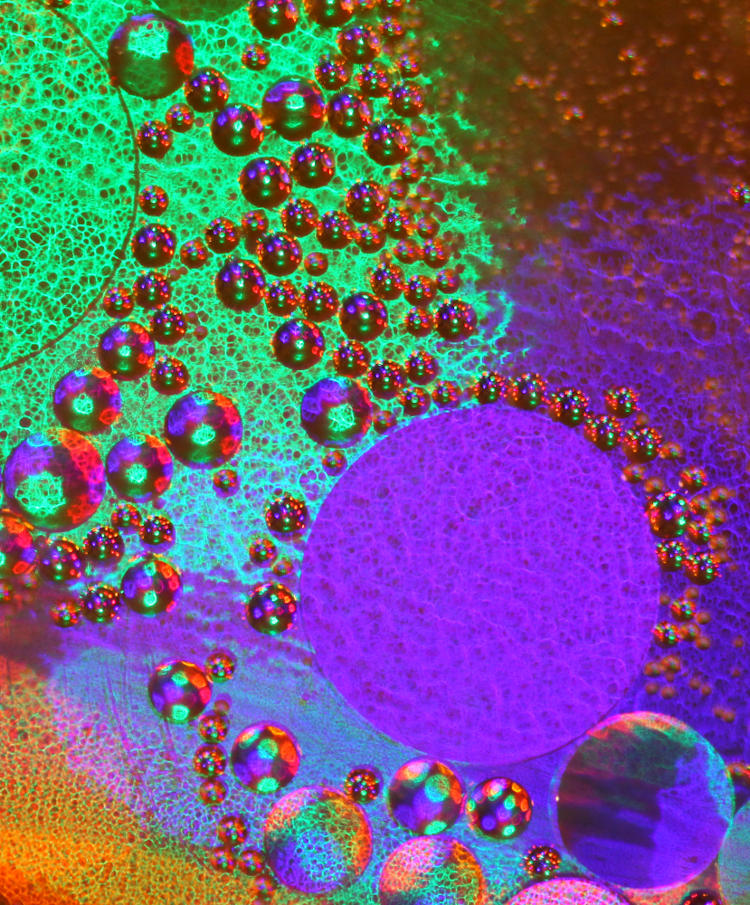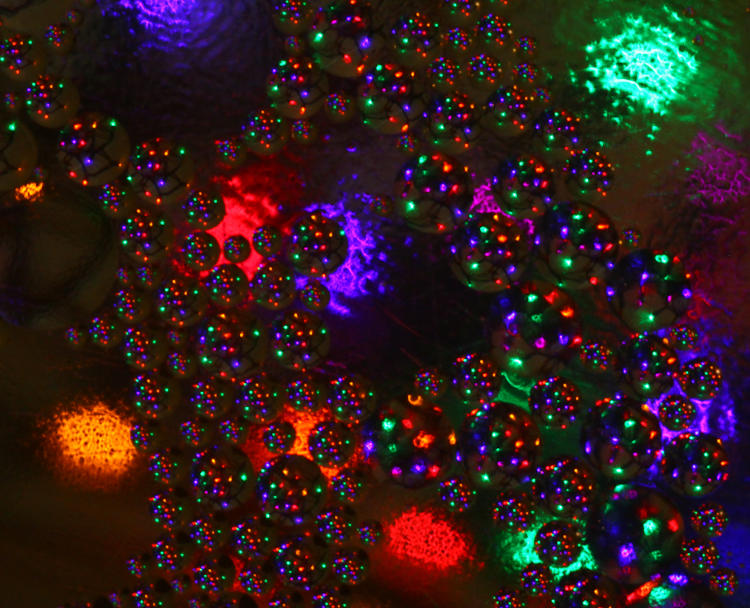I know you were wondering if I was going to show any recognition whatsoever here on the blog that this week is/was Expand on Initial Experiments Week, where you sit down with something that you’d tried out before and build upon it, whether it be a recipe, some new electronic device, or seeing how long certain kinds of pasta will stick to the ceiling. Considering that the week ends in less than two hours as I type this, I’m sneaking in rather late and endeavoring not to wake anyone, like that ever works.
The initial experiment came from earlier this year, and hadn’t turned out too badly for that, but I wanted to try something a little different. I’d floated small drops of vegetable oil in water within a clear glass pan and did extreme closeups while I messed about with light sources, including diffraction from the surface of a CD. I’d tried other backgrounds, but they needed to be farther away to produce a better effect.
Thus, this evening. I fetched up an old window pane and supported it between two chairs so there was open space beneath, and put the glass pan on that. Beneath, I put a cluster of holiday lights.

I was using the Mamiya 80mm macro with extension tube to get the focus right, and because it could be used wide open so the aperture would not be shaping the bokeh. This meant focus depth was very short, which I initially thought wouldn’t be an issue; I was focusing on the oil bubble on the surface. What I found was that the bubbles themselves were one focus point, the images within the bubbles of the lights beneath were another entirely, and I had to chose one or the other.

Not only that, but if I attempted to focus on the lights within the bubbles (which were acting as little lenses themselves,) the focus distance was different depending on the size of the bubble. Keep in mind that all of these are cropped, so what I could see in the viewfinder was much smaller than this. I needed to keep the pan as still as possible because some of the shutter speeds were quite slow, and at macro magnification (the end of the lens being roughly 16cm from the surface of the water,) even slight movement could show in the image, so every time I shifted to get different bubbles, I had to let things die down for a bit. I could kick around the lights underneath to change that effect without issues, though.

In this one, you can actually make out the wires of the cluster of holiday lights simply dumped on the floor beneath the glass – but the focus is widely variable among the bubbles. What you can also see is that I inadvertently snapped the shutter just as two bubbles in the center merged, with the shutter speed being just slow enough to blur this motion.

I closed down the aperture to f16 I think for this one, and it definitely helped the bubbles appear a bit better, while it also resolved the background lights outside of the bubbles from mere color patches to more distinct blobs. This is enough to recognize, if you look very closely, that the bubbles are inverting the background image, which is typical.

But I like this one the best. Instead of trying to focus on the background lights through the bubbles, I just focused on the surfaces of the bubbles themselves, letting the images within defocus into bokeh. A strong sidelight gave definition to the bubble shapes, emphasizing the spherical aspect (or at least the appearance of such.) Now all of the bubbles are similarly focused, lessening the confusion of the image.
So overall, not bad for a couple hours work all told (yes I’m calling it “work” shut up.) I’d done some previous experiments with just the light strands themselves, significantly defocused, and one tip I can offer is that the LED lights, while departing from that yellow incandescent cast of the old ones, nonetheless put out significantly more light in the blue and purple spectrum, and thus these lights can overpower the frame. Not only that, but too fast of a shutter speed will net you a blank frame too often: alternating current causes all lights to blink on and off, generally about 60 times a second (60Hz,) but the glow from incandescent filaments doesn’t fade quickly and so the blinking isn’t captured – not so with LEDS, which switch off instantly. That’s another experiment, though I’ve already captured some initial images.



















































